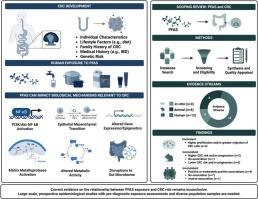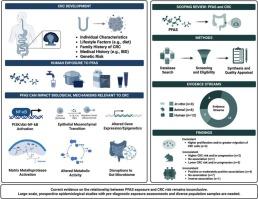单氟烷基和多氟烷基物质(PFAS)与结直肠癌的范围审查:来自体外、动物和流行病学研究的证据
IF 9.7
1区 环境科学与生态学
Q1 ENVIRONMENTAL SCIENCES
引用次数: 0
摘要
聚氟烷基和多氟烷基物质(PFAS)是污染空气、水、土壤和食物的持久性化学物质。由于它们的广泛使用,PFAS在大多数美国人群中都可以检测到,这引起了人们对潜在健康影响的担忧,包括可能与结直肠癌(CRC)有关。我们对先前发表的研究进行了范围综述,以巩固目前对PFAS及其对结直肠癌风险的影响的理解,确定知识空白,并提出未来的研究方向。方法:我们系统地检索PubMed、Scopus和Web of Science,检索截至2024年12月发表的有关PFAS暴露与结直肠癌风险或进展关系的研究。使用标准化协议独立提取数据,并根据预定义的人群、暴露、比较者、结果(PECO)框架进行结构化。为了评估内部效度,研究根据证据流(体外、动物和流行病学)进行分类,并使用既定的质量评价标准进行评估。结果共纳入26项研究,其中综述5项,体外研究3项,动物研究6项,流行病学研究12项。体外研究一致表明,PFAS暴露促进结直肠癌细胞增殖和迁移,突出了关键的机制途径。然而,动物和流行病学研究的结果好坏参半,一些表明肠道肿瘤发生增加,而另一些报告无效或保护作用。值得注意的是,主要的研究是横断面的、回顾性的或生态学的,强调需要高质量的纵向研究来阐明PFAS在结直肠癌风险和进展中的作用。结论关于PFAS暴露与结直肠癌风险之间关系的证据仍然有限且不确定。需要大规模的前瞻性流行病学研究,包括基于生物标志物的暴露评估,包括诊断前PFAS水平、不同人群和严格的研究设计,以阐明PFAS在结直肠癌发展中的作用。这些研究可以提供PFAS在CRC发生和进展中的作用,指导公共卫生政策并支持有针对性的干预措施以降低CRC风险。本文章由计算机程序翻译,如有差异,请以英文原文为准。


A scoping review on per- and poly-fluoroalkyl substances (PFAS) and colorectal cancer: Evidence from in vitro, animal, and epidemiological studies
Background and Aims
Per- and poly-fluoroalkyl substances (PFAS) are persistent chemicals that contaminate air, water, soil, and food. Due to their widespread use, PFAS are detectable in most of the US population, raising concerns about potential health impacts, including a possible association with colorectal cancer (CRC). We conducted a scoping review of previously published studies to consolidate the current understanding of PFAS and its effect on CRC risk, identify knowledge gaps, and propose future directions for research.
Methods
We systematically searched PubMed, Scopus, and Web of Science for studies published through December 2024 that examined PFAS exposure in relation to CRC risk or progression. Data were independently extracted using a standardized protocol and structured according to a predefined Population, Exposure, Comparator, Outcome (PECO) framework. To evaluate internal validity, studies were categorized by evidence stream (in vitro, animal, and epidemiological) and assessed using established quality appraisal criteria.
Results
Twenty-six studies were identified, including 5 reviews, 3 in vitro studies, 6 animal studies, and 12 epidemiological studies. In vitro research consistently demonstrates that PFAS exposure promotes CRC cell proliferation and migration, highlighting key mechanistic pathways. However, findings from animal and epidemiological studies are mixed, with some indicating increased intestinal tumorigenesis while others report null or protective effects. Notably, major studies were cross-sectional, retrospective, or ecological, emphasizing the need for high-quality longitudinal research to clarify PFAS’s role in CRC risk and progression.
Conclusion
Evidence on the relationship between PFAS exposure and CRC risk remains limited and inconclusive. Large-scale, prospective epidemiological studies that incorporate biomarker-based exposure assessment, including pre-diagnostic PFAS levels, diverse populations, and rigorous study design are needed to clarify the role of PFAS in CRC development. Such research could provide the role of PFAS in CRC development and progression, guiding public health policies and support targeted interventions to reduce CRC risk.
求助全文
通过发布文献求助,成功后即可免费获取论文全文。
去求助
来源期刊

Environment International
环境科学-环境科学
CiteScore
21.90
自引率
3.40%
发文量
734
审稿时长
2.8 months
期刊介绍:
Environmental Health publishes manuscripts focusing on critical aspects of environmental and occupational medicine, including studies in toxicology and epidemiology, to illuminate the human health implications of exposure to environmental hazards. The journal adopts an open-access model and practices open peer review.
It caters to scientists and practitioners across all environmental science domains, directly or indirectly impacting human health and well-being. With a commitment to enhancing the prevention of environmentally-related health risks, Environmental Health serves as a public health journal for the community and scientists engaged in matters of public health significance concerning the environment.
 求助内容:
求助内容: 应助结果提醒方式:
应助结果提醒方式:


